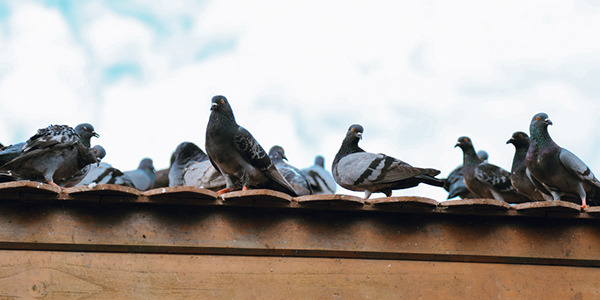How to Prevent Bird Damage to Your Roof
Author: Lee Polevoi | May 5, 2023
Preventing bird damage to your roof is a smart measure to help protect and extend the life of your roof. First, though, it's helpful to understand how the presence of birds can create problems for homeowners.

Bird Droppings, Nests and the Threat of Fire
The primary concern for roofs in many cases is bird droppings. The waste caused by birds is very acidic in nature, with the capacity to steadily erode asphalt shingles and other forms of roofing materials. Left unchecked, bird droppings can also damage roof tar and tar paper. It can undermine the lifespan of paint on a roof. Damage to shingles can result in unwanted leaks, which lead to further damage to a roof and house.
Birds like to peck at the ground (and other surfaces) in search of seeds, grains and insects. This type of avian behavior can result in punctures in a roof, which lead to possible leaks.
Birds' nests are another area of concern for homeowners. Birds like to build nests in gutters, which can inhibit proper water drainage. Water that doesn't drain the way it should often causes pooling and seepage. This can end up causing mildew and mold.
Another related issue with birds' nests is the threat of flammable materials being where homeowners certainly don't want them. A bird's nest is generally made up of twigs, grass, straw, calcified bird droppings and other natural materials that can easily catch fire. The threat becomes even more pronounced when nests are located in or close by electrical machinery (HVAC units, ventilation systems, etc.). It's imperative that homeowners do all they can to prevent any potential fire damage to their structures.
Preventing Bird Damage to Your Roof
There are many steps homeowners can take to reduce the threats posed by birds' nests and droppings — all without causing any harm to our winged friends.
First, clean away bird droppings on your roof:
- Aim your garden hose at bird droppings and turn on the water. Don't try to blast the droppings with high-pressure water hoses as this may result in damage to shingles and other roofing materials.
- Purchase bird poop remover or cleaner, a strong solution to extensive bird droppings on the roof.
The best way to protect your roof is to remove the threat in the first place with the following preventative measures:
- Safely climb a ladder and remove a bird's nest by hand.
- Set up a "predator decoy" — a fake owl or hawk — that alarms birds approaching your roof and deters them from trying again.
- Purchase repellent gel that makes a roof surface sticky and unpleasant for birds.
- Use netting to protect the roof or humane anti-roosting strips. This is frequently employed on commercial structures to discourage birds from landing on the roof.
All of these steps can minimize roof damage and, ideally, keep birds off of a roof for good.
Repairing Bird Damage on a Roof
Pools of water that gather on a ledge or flat roof often attract thirsty birds. When they collect to have a drink or enjoy a bird-bath, they may be tempted to linger there or keep coming back. The solution is to contact a skilled, experienced roofing contractor who can address the problem of "ponding" and remove the additional risks posed by bird droppings or nests.
Another appealing situation for birds are gravel roofs. Consuming a small portion of gravel aids in a bird's digestive process, and they also like to incorporate tiny chunks of gravel in their nests. Consider replacing a gravel roof with less "bird-friendly" materials or employ some of the above-mentioned tactics to make conditions too uncomfortable for birds to linger.
Finally, inspect your roof — or have a roofing contractor undertake this task — in order to identify any holes or gaps in shingles that also draw birds to a home. These gaps should be sealed or repaired as soon as possible so that problems can be prevented before they become an actual threat to the care of your roof.
Having birds in your neighborhood may be pleasant for the most part, but it's okay to draw the line when they start gathering on your roof. Taking measures to discourage their presence can add significantly to the lifespan of your roof. The good news is, there are plenty of tactics to employ without causing any harm to our feathered friends!